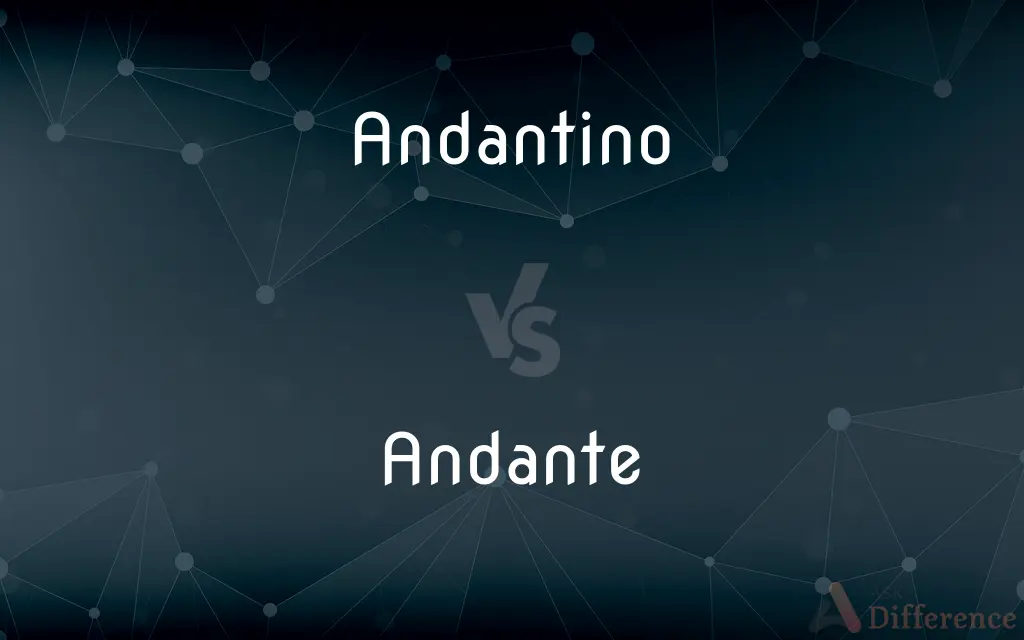Andantino vs. Andante — What's the Difference?
By Tayyaba Rehman & Fiza Rafique — Updated on April 15, 2024
Andantino is often faster or slightly faster than Andante, though historically it could mean slightly slower; both terms are musical tempos marking moderate pace.

Difference Between Andantino and Andante
Table of Contents
ADVERTISEMENT
Key Differences
Andantino was traditionally understood as slightly slower than Andante, reflecting a very gentle pace in music. However, in modern usage, it is frequently interpreted as slightly faster than Andante, introducing a subtle yet distinct variation in musical expression. On the other hand, Andante is a standard tempo marking in music that suggests a walking pace, which is moderately slow and steady. This provides musicians and conductors with a baseline for the tempo, whereas Andantino offers a nuance that can slightly raise the pace, making the piece feel a bit more lively.
While Andantino can vary in interpretation, being either slightly slower or faster than Andante depending on the historical or geographical context, Andante has a more universally accepted definition. This difference affects how music scores are approached by performers. Whereas Andante gives a clear directive for a calm and consistent tempo, Andantino allows for a degree of flexibility, making the performance subtly brisker or relaxed based on the composer’s or conductor's intent.
On the other hand, in terms of placement within musical compositions, both Andantino and Andante are used to convey a lighter, more delicate mood compared to faster tempos like Allegro or Presto. However, Andantino, by being potentially faster, might lead to a slightly more upbeat and less somber atmosphere than Andante.
Composers use these tempo markings to guide the emotional and dynamic flow of the music. Andantino, with its dual interpretation, can add a layer of complexity to a piece, requiring careful consideration from the performer to align with the intended mood. Whereas, Andante is often more straightforward, aiming for an even, flowing rhythm that supports a wide range of musical expressions without much ambiguity.
Understanding the subtle differences between Andantino and Andante is crucial for musical interpretation, especially in classical and romantic compositions where expressive depth is paramount. While Andante sets a clear expectation of tempo, Andantino requires a nuanced understanding of the composer's intentions, which may not be explicitly stated in the score.
ADVERTISEMENT
Comparison Chart
Definition
A tempo marking that can mean slightly slower or faster than Andante.
A tempo marking that generally indicates a moderate walking pace.
Speed
Slightly variable; usually considered slightly faster in modern contexts.
Consistently moderate, steady pace.
Emotional Tone
Can vary from slightly lively to gently relaxed, depending on speed.
Typically conveys a calm, even expression.
Usage Flexibility
Offers more flexibility in interpretation.
More straightforward and universally understood.
Historical Interpretation
Historically sometimes considered slower than Andante.
Has maintained a consistent interpretation over time.
Compare with Definitions
Andantino
Sometimes historically used to denote a pace slightly slower than Andante.
In early 19th-century compositions, Andantino could suggest a more leisurely pace.
Andante
A tempo marking indicating a moderate, walking pace.
The concerto opens with an Andante that sets a reflective tone.
Andantino
A musical term indicating a tempo slightly faster than Andante.
The piece transitions into an Andantino section, offering a brisker feel.
Andante
Aims for an even, flowing rhythm in performances.
She played the Andante section with perfect fluidity.
Andantino
Offers subtle flexibility in musical expression.
Her interpretation of the Andantino was lively, yet delicate.
Andante
Serves as a baseline for moderate tempo.
The orchestra returned to Andante after the faster movements.
Andantino
Used to modify the mood in various sections of music.
The Andantino movement added a playful contrast to the preceding solemn Andante.
Andante
Universally understood in musical notation.
Musicians universally recognize Andante as a moderate pace.
Andantino
Reflects slight variations in tempo across different musical eras.
Depending on the era, Andantino might accelerate or decelerate the tempo slightly.
Andante
Commonly used in classical music to indicate steadiness.
He maintained an Andante pace throughout the sonata.
Andantino
In a tempo variously construed as slightly faster or slower than andante. Used chiefly as a direction.
Andante
In a moderately slow tempo, usually considered to be slower than allegretto but faster than adagio. Used chiefly as a direction.
Andantino
An andantino passage or movement.
Andante
An andante passage or movement.
Andantino
(music) Of a tempo that is slightly faster than andante but slower than moderato.
Andante
(music) A tempo mark directing that a passage is to be played in a moderately slow tempo; faster than adagio but slower than moderato.
Andantino
A piece of music played in this style.
Andante
(music) A passage having this mark.
Andantino
Rather quicker than andante; between that allegretto.
Andante
(music) Played at a moderately slow tempo.
Andantino
(of tempo) moderately fast
Andante
(music) Describing a passage having this mark.
Andante
Moving moderately slow, but distinct and flowing; quicker than larghetto, and slower than allegretto.
Andante
A moderately slow tempo (a walking pace)
Andante
(of tempo) moderately slow
Andante
At a moderately slow temp;
This passage must be played andante
Common Curiosities
What does Andantino mean in music?
Andantino can mean slightly faster or, historically, slightly slower than Andante, offering a subtle variation in pace.
How does the interpretation of Andantino affect musical performance?
The dual interpretation of Andantino requires musicians to understand the context and intentions of the composer, potentially altering the piece’s mood and pace.
How does Andante differ from Andantino in tempo?
Andante consistently indicates a moderate walking pace, while Andantino’s tempo can be slightly variable, generally faster in contemporary usage.
Can Andantino ever be slower than Andante?
Historically, Andantino was sometimes interpreted as slower than Andante, though this usage is less common today.
Why is Andante considered a universal musical term?
Andante is widely accepted as representing a steady, moderate pace, making it a staple in musical tempo markings.
Is there a specific genre where Andantino or Andante is more prevalent?
Both Andantino and Andante are commonly found across various genres of classical music, particularly in symphonies and chamber music, where nuanced tempo control enhances expressive depth.
What role does Andantino play in expressing emotion in music?
Andantino can subtly influence the emotional tone of a piece, either heightening the energy or softening it, depending on whether it is interpreted as slightly faster or slower than Andante.
How do conductors interpret Andantino when leading an orchestra?
Conductors must make interpretative decisions about Andantino, potentially consulting historical sources or the composer's notes to decide whether to lean towards a slightly faster or slower tempo than Andante, influencing the orchestra's overall performance.
Do composers today still use Andantino in their compositions?
Yes, composers continue to use Andantino to specify tempo nuances that differ from the more straightforward Andante, allowing for personalized expression in modern compositions.
How should musicians approach a piece marked Andantino versus one marked Andante?
Musicians should consider the historical and stylistic context of the piece when approaching Andantino, as its tempo can vary, while Andante typically calls for a steady, moderate pace that is less ambiguous.
Share Your Discovery

Previous Comparison
Eave vs. Gutter
Next Comparison
Rakija vs. RakiAuthor Spotlight
Written by
Tayyaba RehmanTayyaba Rehman is a distinguished writer, currently serving as a primary contributor to askdifference.com. As a researcher in semantics and etymology, Tayyaba's passion for the complexity of languages and their distinctions has found a perfect home on the platform. Tayyaba delves into the intricacies of language, distinguishing between commonly confused words and phrases, thereby providing clarity for readers worldwide.
Co-written by
Fiza RafiqueFiza Rafique is a skilled content writer at AskDifference.com, where she meticulously refines and enhances written pieces. Drawing from her vast editorial expertise, Fiza ensures clarity, accuracy, and precision in every article. Passionate about language, she continually seeks to elevate the quality of content for readers worldwide.














































